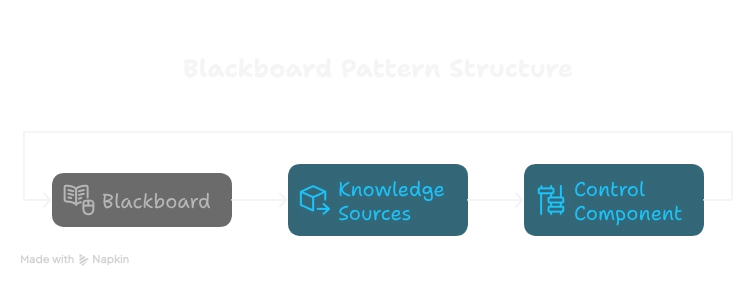The Blackboard Pattern: A Framework for Complex Problem Solving
Hi there! I’m Maneshwar. Currently, I’m building a private AI code review tool that runs on your LLM key (OpenAI, Gemini, etc.) with flat, no-seat pricing — designed for small teams. Check it out, if that’s your kind of thing.
In software architecture, the Blackboard Pattern is a powerful design pattern that provides a centralized knowledge repository where multiple independent modules (called knowledge sources) can collaborate to solve complex problems.
This approach is particularly useful when no single algorithm or subsystem can solve the problem entirely, but instead requires contributions from diverse specialized modules.
Originally identified in the Hearsay-II project for speech recognition, the Blackboard Pattern has since been applied in domains such as artificial intelligence, decision-making systems, and real-time signal interpretation.
What is the Blackboard Pattern?
At its core, the Blackboard Pattern is a behavioral design pattern that enables independent modules to communicate and work together through a shared “blackboard.”
Each module operates autonomously but contributes incrementally to the global solution by updating or interpreting data from the blackboard.
This makes it especially valuable in scenarios where problems are ill-structured, uncertain, or require non-deterministic reasoning.
Structure of the Blackboard Pattern
The Blackboard architectural model consists of three main components:
- Blackboard – A structured global memory that contains all relevant data, hypotheses, and intermediate results.
- Knowledge Sources – Specialized, independent modules that contribute to the problem-solving process using their domain expertise.
- Control Component – A scheduler or controller that manages execution by deciding which knowledge source should act next, often based on heuristics or priorities.
How It Works (Implementation Steps)
-
Design the Solution Space
Define the problem domain and structure the blackboard to represent potential solutions. -
Identify Knowledge Sources
Develop specialized modules that can process data, test hypotheses, or refine results. -
Implement the Control Component
Create a scheduler that decides which knowledge source should run based on the state of the blackboard. This often involves domain-specific heuristics for prioritization.
Applications of the Blackboard Pattern
The pattern has been widely used in AI and complex data analysis systems. Notable application areas include:
- Speech recognition (its original use case in Hearsay-II)
- Vehicle identification and tracking
- Protein structure analysis
- Sonar signal interpretation
Benefits of the Blackboard Pattern
The Blackboard approach offers several advantages for complex systems:
- Reusability – Knowledge sources can be reused across different problems.
- Changeability – New knowledge sources can be added without redesigning the whole system.
- Robustness – The system can continue functioning even if some modules fail.
- Parallelism – Multiple processes can run concurrently, polling and reacting as needed.
When to Use the Blackboard Pattern
You should consider using the Blackboard Pattern when:
- The problem space is too complex for a single algorithm.
- Multiple specialized modules need to collaborate dynamically.
- The solution requires incremental progress rather than a single deterministic computation.
Conclusion
The Blackboard Pattern is more than just a design choice—it’s a problem-solving paradigm.
By enabling multiple independent modules to collaborate through a shared knowledge base, it allows developers to tackle highly complex, uncertain, and dynamic systems.
From its early roots in speech recognition to modern applications in AI and real-time analysis, the Blackboard Pattern continues to prove its value in scenarios where traditional approaches fall short.
LiveReview helps you get great feedback on your PR/MR in a few minutes.
Saves hours on every PR by giving fast, automated first-pass reviews. Helps both junior/senior engineers to go faster.
If you’re tired of waiting for your peer to review your code or are not confident that they’ll provide valid feedback, here’s LiveReview for you.



